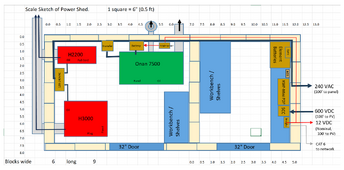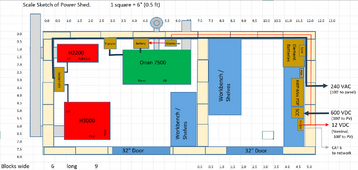I’m using 2 xw pro’s and two eg4 100 charge controllers.
I have often read in posts that these charge controllers and inverter chargers are loud when operating. Is there any way to quantify that?
I realize loud is subjective. However can someone who has similar equipment give me a better description that might let me duplicate that level of sound approximately so I can do some testing?
I am looking at locations to place my equipment. I live in a well built manufactured home
I have read that there can be quite a bit of fan noise and transformer noise from this equipment .
I have one location that I would love to use but has a bedroom on the other side of the wall from it.
It is a fairly ideal location relative to the main panel. It cuts out a lot of electrical work, surge protection equipment, kw being consumed by air conditioning load, and expensive lightening protection products that will be required if I place the equipment outside in an insulated shipping container.
If the equipment ends up in the house I‘ll be building a second wall about an inch from the existing bedroom wall because the house walls are unlikely sturdy enough to support the weight properly. I need 8 feet of equipment mounting wall but could extend the wall further and take measures to minimize sound transmission. It’s a lot of work placing the equipment in either location. If placed in the house I don’t want to build more sound proofing than I need because of the expense and the work involved. I can also blow insulation into the existing bedroom wall and put a second layer of drywall over it if needed. But that is something that must be done before construction of the wall the equipment will be mounted on. It will be impossible to retrofit that insulation into the stud cavities once the equipment has been installed on a second wall in front of the original bedroom wall.
It’s one of those things that need to be done correctly the first time, if I choose to go that route. If it is simply a matter of fan noise perhaps using a ducted blower in place of the equipment fans might be an option and the wall can be placed on the existing carpet or neoprene stripping to further isolate the building from vibration.
Is the expected noise similar to a 50” tv with the volume on med or high listening to the news or is it actually more?
Is it like lifting the hood of a car when it running. Or perhaps more like the car with the hood up is idling then the radiator cooling fan kicks on? That level of noise?
Do either of these companies, eg4 or Schneider publish decibel numbers so I could buy a db meter and simulate the noise level on site?
I’m trying to figure out what it would take sound proofing wise ($$) to place the equipment inside vs the cost of a much further away location which will require additional air conditioning kw load on the system, an additional $300-400 dollars for wire plus additional $3-400 for surge protection devices for the rs485 lines and power lines.
If you have this equipment or work around it and are willing to describe how loud it is at it’s worse moments I’d be quite appreciative. I realize it’s not going to be a perfect description but I’ll be happy with whatever I can get. My only other option is to set it all up in one location, try to load it up till it’s making peak noise. Then determine what I need and make my decision from that.
Thanks.
I have often read in posts that these charge controllers and inverter chargers are loud when operating. Is there any way to quantify that?
I realize loud is subjective. However can someone who has similar equipment give me a better description that might let me duplicate that level of sound approximately so I can do some testing?
I am looking at locations to place my equipment. I live in a well built manufactured home
I have read that there can be quite a bit of fan noise and transformer noise from this equipment .
I have one location that I would love to use but has a bedroom on the other side of the wall from it.
It is a fairly ideal location relative to the main panel. It cuts out a lot of electrical work, surge protection equipment, kw being consumed by air conditioning load, and expensive lightening protection products that will be required if I place the equipment outside in an insulated shipping container.
If the equipment ends up in the house I‘ll be building a second wall about an inch from the existing bedroom wall because the house walls are unlikely sturdy enough to support the weight properly. I need 8 feet of equipment mounting wall but could extend the wall further and take measures to minimize sound transmission. It’s a lot of work placing the equipment in either location. If placed in the house I don’t want to build more sound proofing than I need because of the expense and the work involved. I can also blow insulation into the existing bedroom wall and put a second layer of drywall over it if needed. But that is something that must be done before construction of the wall the equipment will be mounted on. It will be impossible to retrofit that insulation into the stud cavities once the equipment has been installed on a second wall in front of the original bedroom wall.
It’s one of those things that need to be done correctly the first time, if I choose to go that route. If it is simply a matter of fan noise perhaps using a ducted blower in place of the equipment fans might be an option and the wall can be placed on the existing carpet or neoprene stripping to further isolate the building from vibration.
Is the expected noise similar to a 50” tv with the volume on med or high listening to the news or is it actually more?
Is it like lifting the hood of a car when it running. Or perhaps more like the car with the hood up is idling then the radiator cooling fan kicks on? That level of noise?
Do either of these companies, eg4 or Schneider publish decibel numbers so I could buy a db meter and simulate the noise level on site?
I’m trying to figure out what it would take sound proofing wise ($$) to place the equipment inside vs the cost of a much further away location which will require additional air conditioning kw load on the system, an additional $300-400 dollars for wire plus additional $3-400 for surge protection devices for the rs485 lines and power lines.
If you have this equipment or work around it and are willing to describe how loud it is at it’s worse moments I’d be quite appreciative. I realize it’s not going to be a perfect description but I’ll be happy with whatever I can get. My only other option is to set it all up in one location, try to load it up till it’s making peak noise. Then determine what I need and make my decision from that.
Thanks.




